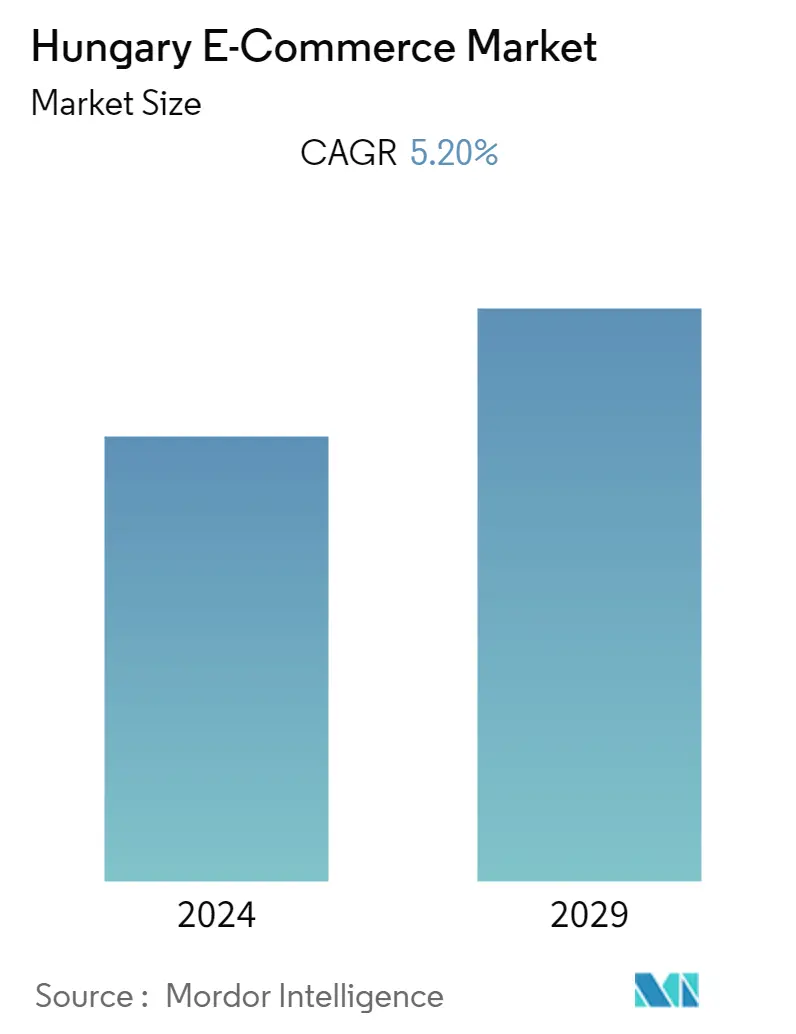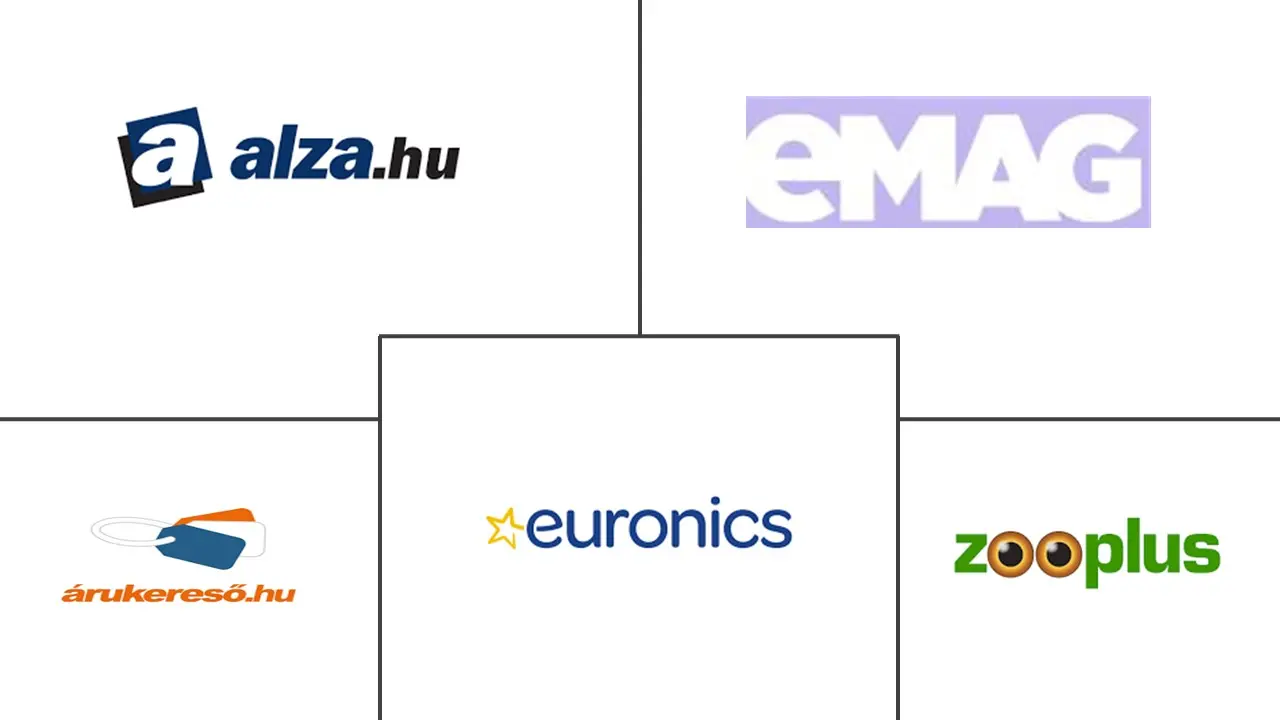Market Size of Hungary E-Commerce Industry

| Study Period | 2019 - 2029 |
| Base Year For Estimation | 2023 |
| Forecast Data Period | 2024 - 2029 |
| Historical Data Period | 2019 - 2022 |
| CAGR | 5.20 % |
| Market Concentration | Medium |
Major Players
*Disclaimer: Major Players sorted in no particular order |
Hungary Ecommerce Market Analysis
Hungary is a country of the upper-middle class with a very high Human Development Index, considering life expectancy, education, and living standards. According to the International Trade Administration, Hungary's e-commerce generated USD 2.04 billion in total revenue in 2020, accounting for 6.2% of total retail revenue. In addition, the country plans to register an annual growth rate of 5.2% during the forecast period 2022 - 2027.
- E-commerce can boost Hungary's productivity and innovation; the Hungarian government continues to prioritize promoting this sector. E-commerce has made a slow start in Hungary but has been booming in recent years. The growth rate of new online shoppers has slowed in the last few years, but the Covid 19 pandemic has led to significant growth in e-commerce.
- Further, the most developed segment in the country is claimed to be electronic banking. The growth rate of new online shoppers has slowed in the last few years, but the Covid 19 pandemic has led to significant growth in e-commerce.
- The most commonly purchased products online include books, coupons, IT and electronics, insurance services, e-tickets, and holiday bookings. According to E-commerce Europe, over 70% of orders have a courier, most Hungarian online shoppers prefer cash on delivery, and Hungarian online buyers use cash payments upon delivery. Most e-commerce revenue (almost 40%) occurs in the last two months of the year before the holiday season.
- The Hungarians increased their presence in the virtual world during the blockade of the Covid-19 pandemic. According to Bigcommerce, 83% of Hungarians and 81% of Europeans regularly buy big discounts at home improvement stores. According to the International Trade Administration, they spend hours searching for the best deals online.
Hungary Ecommerce Industry Segmentation
E-commerce (electronic commerce) is the buying and selling of goods and services, or the transfer of funds and data, mainly via electronic networks, the Internet. These business transactions are either business-to-business (B2B), business-to-consumer (B2C), consumer-to-consumer, or consumer-to-consumer. The Hungary E-commerce Market is Segmented by B2C eCommerce (Beauty and Personal Care, Consumer Electronics, Fashion and Apparel, Food and Beverage, Furniture and Home), and B2B eCommerce.
| By B2C ecommerce | ||||||||
| Market size (GMV) for the period of 2017-2027 | ||||||||
|
| By B2B ecommerce | |
| Market size for the period of 2017-2027 |
Hungary E-Commerce Market Size Summary
The Hungary e-commerce market is experiencing significant growth, driven by increased internet penetration, a rising urban population, and the widespread adoption of mobile web traffic. The sector has seen a transformation in consumer purchasing behavior, particularly due to the COVID-19 pandemic, which accelerated the shift towards online shopping. The market is characterized by a diverse range of products, with fashion, electronics, and groceries leading the demand. The rise of cashless payments and the convenience of 24/7 accessibility have further disrupted traditional shopping habits, making e-commerce an integral part of the Hungarian retail landscape. Despite challenges such as customer retention and environmental concerns, the market continues to expand, with multinational retailers like H&M dominating the online fashion segment.
The competitive landscape of Hungary's e-commerce market is moderately intense, with numerous players introducing innovative technological solutions to enhance the online shopping experience. Companies like Alza and eMAG are expanding their presence, with eMAG planning to open multiple showrooms and aiming for significant sales growth. The market is also witnessing trends such as personalization and the integration of artificial intelligence, which are expected to shape its future trajectory. Additionally, sustainability initiatives, like those implemented by Auchan, are gaining traction, reflecting a broader commitment to environmental responsibility within the industry. As the market evolves, it presents both opportunities and challenges, with the potential for continued expansion and innovation in the coming years.
Hungary E-Commerce Market Size - Table of Contents
-
1. MARKET INSIGHTS
-
1.1 Market Overview
-
1.2 Industry Attractiveness-Porter's Five Forces Analysis
-
1.2.1 Bargaining Power of Suppliers
-
1.2.2 Bargaining Power of Buyers/Consumers
-
1.2.3 Threat of New Entrants
-
1.2.4 Threat of Substitute Products
-
1.2.5 Intensity of Competitive Rivalry
-
-
1.3 Key market trends and share of e-commerce of total Retail sector
-
1.4 Impact of COVID-19 on the e-commerce sales
-
-
2. Market Segmentation
-
2.1 By B2C ecommerce
-
2.1.1 Market size (GMV) for the period of 2017-2027
-
2.1.2 Market Segmentation - by Application
-
2.1.2.1 Beauty & Personal Care
-
2.1.2.2 Consumer Electronics
-
2.1.2.3 Fashion & Apparel
-
2.1.2.4 Food & Beverage
-
2.1.2.5 Furniture & Home
-
2.1.2.6 Others (Toys, DIY, Media, etc.)
-
-
-
2.2 By B2B ecommerce
-
2.2.1 Market size for the period of 2017-2027
-
-
Hungary E-Commerce Market Size FAQs
What is the current Hungary E-Commerce Market size?
The Hungary E-Commerce Market is projected to register a CAGR of 5.20% during the forecast period (2024-2029)
Who are the key players in Hungary E-Commerce Market?
Alza.hu, Arukereso.hu, eMAG, Zooplus SE and Euronics Technical Store Chain are the major companies operating in the Hungary E-Commerce Market.

